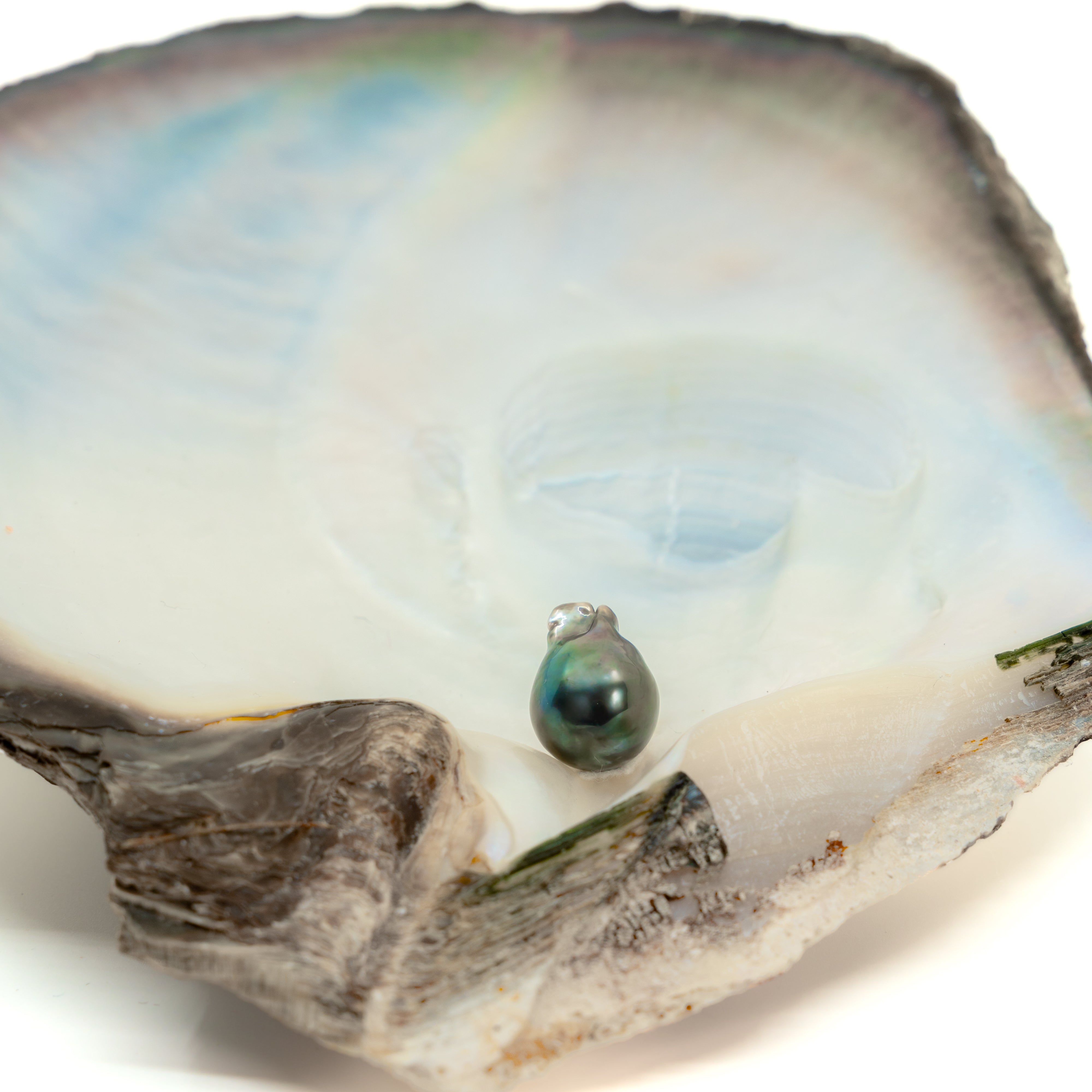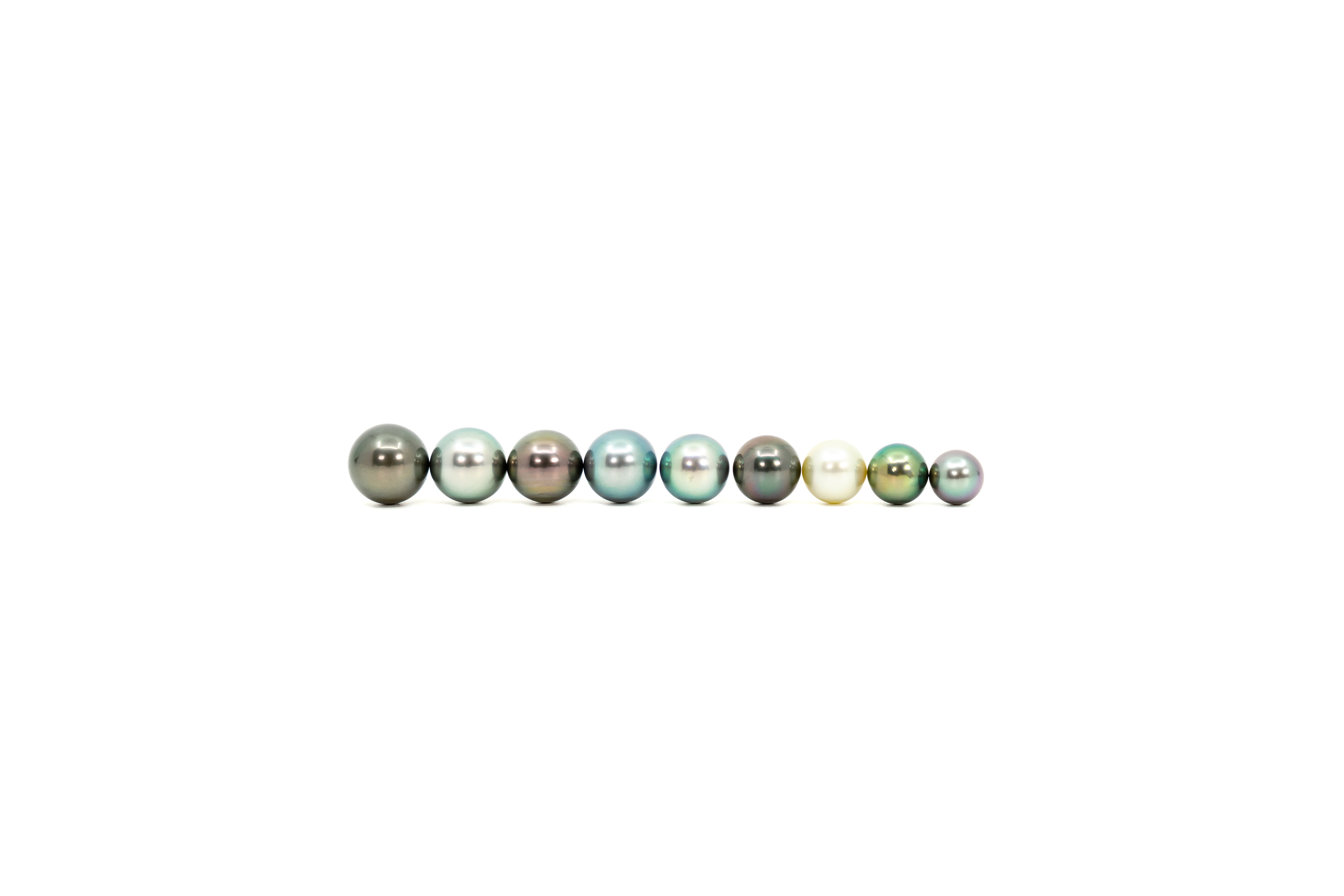The pearl
The Tahitian cultured pearl comes from the Pinctada Margaritifera pearl oyster, which only lives in a few lagoons in French Polynesia. It is fragile, requires an unpolluted environment and water between 25° and 35°. It is called a black pearl, Poerava in Tahitian, but in reality it has the most diverse palette of natural colors. This is what makes it beautiful, unique, and one of the most beautiful natural ornaments.

The graft
It involves inserting a graft (a piece of mantle, the "black lip") taken from a donor oyster into the pearl pouch of the pearl oyster, combined with a nucleus (a marble made from a Mississippi shell). To protect itself from this intrusion, the oyster will secrete mother-of-pearl to "isolate" the nucleus. This process lasts about two years, during which the pearl oysters are regularly cleaned and protected from parasitic intrusions.

Quality and classification
The two are too often associated, whereas a pearl of classification "C" (A in international classification) may have only two imperfections distributed on the two poles of its surface, a very beautiful luster and an exceptional color.
Quality
The quality of the pearl is guaranteed by its layer of nacre, which must be thick enough to resist adverse factors (skin acidity, perfume, dry air, etc.). It takes about 2 years to obtain a satisfactory layer of nacre.
Classification
Two criteria mainly determine the classification: imperfections on the surface of the pearl, and its luster (its shine). The color of Tahitian pearls is entirely natural and this criterion is theoretically not taken into account in the calculation of the price. However, some pearls with very rare colors will be more expensive; these are the so-called "collector's" pearls presented on some of our models (mention "collector's pearl" in the product description).
The Polynesian classification of Tahitian pearls is defined as follows:
-Perfect pearl (Top Gem): pearl without imperfection. Excellent luster. Only a "naked" pearl (not mounted in jewelry) can obtain this designation. As soon as the pearl is pierced it is downgraded and becomes a category A pearl (AAA in international classification)
- Category A (AAA in international classification): pearl without imperfections on 90% of its surface. On the remaining 10%, the pearl may have slight, concentrated imperfections, with a tolerance of a single deep imperfection. Very beautiful luster at least.
- Category B (AA in international classification): pearl without imperfections on 70% of its surface. On the remaining 30%, the pearl may have slight, concentrated imperfections, with a tolerance of two deep imperfections. Good luster at least.
- Category C (A in international classification): pearl without imperfections on 40% of its surface. On the remaining 60%, the pearl may have concentrated slight imperfections, with a tolerance of 10% for deep imperfections. Medium luster at least.
- Category D: Pearl with slight imperfections on more than 60% of its surface, with a tolerance of 20% for deep imperfections. Low luster at least.
Note: Luster can downgrade a pearl. For example, a pearl with less than 10% light, concentrated imperfections will be a category A if its luster is very good; if it is just good, it will be a category B pearl. Conversely, a category B or C pearl may have excellent luster.

Size and shape
Size
The size of the pearls depends on the size of the nucleus (the kernel inserted by the grafter) of the oyster itself. The majority of pearls range between 7.5 mm and 14 mm. Pearls with a beautiful surface are rare and are considered treasures!
The different forms
-the round pearl: spherical pearl, with a variation in its diameter of less than 2%.
-the semi-round pearl: a round pearl, with a variation in its diameter of between 2% and 5%.
-the semi-baroque pearl (drop, oval, button, circled): pearl presenting at least one axis of symmetry.
-the baroque pearl: irregular pearl, possibly circled.
Price of pearls
The price of a pearl depends on its shape, size, and classification. An exceptional color can also influence the pearl's value. The higher the classification, the more expensive the pearl will be. For equal size and classification, the round pearl is the most expensive because it is the rarest (less than 5% of a harvest), followed by the semi-round pearl, then the semi-baroque pearl, and finally the baroque pearl. The larger the size, the higher the price increases, and exponentially.
Please note: The pearl oyster farming process is lengthy and occurs only in a very small part of the Pacific Ocean. Harvests are therefore limited, which explains the relatively high price of the Black Pearl compared to other pearls.
Choosing your pearl
The price of a pearl depends on its shape, size, and classification. An exceptional color can also influence the pearl's value. The higher the classification, the more expensive the pearl will be. For equal size and classification, the round pearl is the most expensive because it is the rarest (less than 5% of a harvest), followed by the semi-round pearl, then the semi-baroque pearl, and finally the baroque pearl. The larger the size, the higher the price increases, and exponentially.
Please note: The pearl oyster farming process is lengthy and occurs only in a very small part of the Pacific Ocean. Harvests are therefore limited, which explains the relatively high price of the Black Pearl compared to other pearls.
Maintenance and precautions
To keep your pearls shiny, avoid contact with chemicals such as chlorinated pool water, shampoo, soap, perfume, hairspray, and cleaning products. Apply perfume before putting on your jewelry. It is also recommended not to wear pearls during sports sessions, as the acidity of perspiration can affect the luster of the gemstone.
Contrary to popular belief, pearls do not "die" if they are not worn. However, the presence of water (2%) in the composition of mother-of-pearl must be taken into account in specific situations. Avoid heat sources. If you store your pearls for a long time in a safe or a very dry place, remember to add a glass of water next to them to maintain a sufficient humidity level.
Pearls are made of mother-of-pearl, a mineral material that withstands shocks well, however they can be scratched when in contact with even harder materials (metals, other jewelry, stones). Avoid contact between your pearls and these stones and metals, including when storing them.
After wearing a pearl, clean it with a soft cloth, possibly moistened with bottled water. And that's it!
THE KESHI
A small grain of sand or a tiny shrimp enters the oyster as it opens to feed; the oyster secretes mother-of-pearl around it to protect itself before expelling it. This is how keshi, these small irregularly shaped pieces of mother-of-pearl, are formed. From time to time, the oyster may reject the nucleus, and a keshi is then formed with the small piece of graft.
Their sizes, colors, and shapes vary enormously, although they are mostly iridescent gray in tone.
They are made of pure mother-of-pearl, just like the fine pearls that lucky people used to find in pearl oysters!
Their baroque shape allows the creation of modern and unique jewelry.
Pearl farmers regularly find these Keshi in pearl oysters before they have had time to expel them.
Keshi of good size (over 10 mm) are rarer and gain a lot of value beyond 12 mm.
